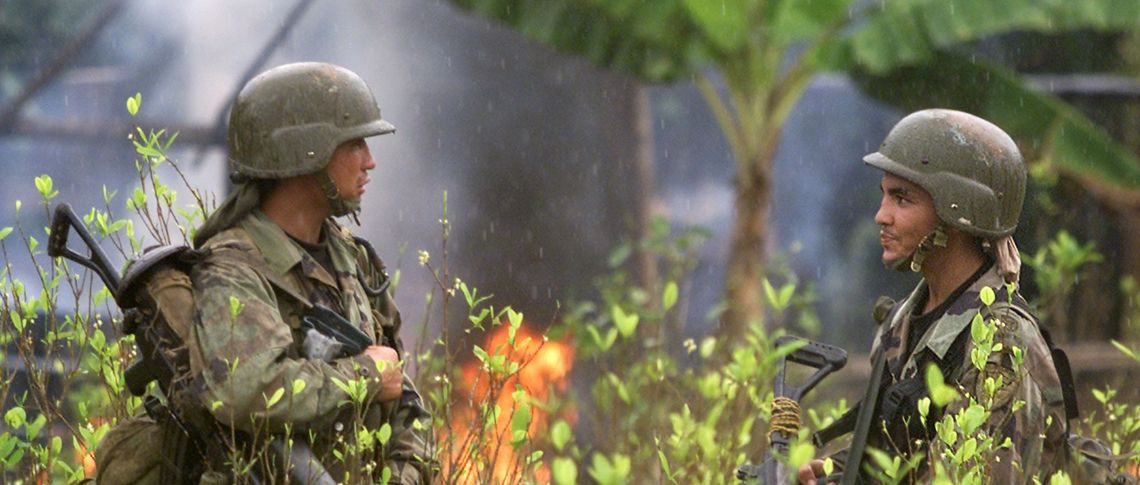The deadline for the FARC to return the slain bodies of the 27 Awa indigenous community members killed earlier this month expired at 6:00 PM on February 23, 2009. The killings, carried out on two separate occasions in the Nariño area of southwestern Colombia, have brought terror to the region and left more than 400 indigenous members displaced.
Awa leader Robinson Pay called for the return of the bodies last week, warning that failure to do so would force the indigenous community to search for the bodies themselves. The Tortugaña Telembi Reservation (Barbacoas municipality), where the murders are presumed to have taken place, is located in a remote tropical mountain region 12 hours from the nearest city. Difficulty in accessing the site has been exacerbated by the proliferation of landmines on access roads, the presence of illegal armed forces and by torrential rains which have caused massive flooding, affecting no less than 42,000 people in the area and leaving an estimated 5,300 people without homes, 8 dead and 14 missing. So far, an estimated 1,000 Awa’s, including members from Bolivia, Brazil, Ecuador, Peru and Colombia, have assembled for the recovery effort.
The executions, carried out on February 5 and 6, 2009, are attributed to the Revolutionary Armed Forces of Colombia. According to preliminary reports, the armed guerilla (FARC) forces swept into the Awa village (population 200), on February 4, 2009. Accused of funneling intelligence regarding FARC movements to the military, a group of 20 or so community members were tied together and taken to a hillside near a river. Three escaped. The remaining seventeen were executed. Only days later, ten others met a similar fate. The FARC has admitted to the murders of only eight of the seventeen murders. Three bodies, all exhibiting signs of torture, have been found thus far.
Although the Colombian government and the international community have categorically denounced these crimes as a violation of human rights, not much has been done to recover the bodies. The Indigenous community has accused the government of taking advantage of the tragedy to gain Indigenous support for the persecution of insurgent groups on ancestral lands by means of war. That is why the Awa community has expressed that they will not accept the help of the Colombian Armed Forces. Instead, they have reached out to foreign governments for assistance in removing landmines from the area.
The murders come as no surprise to the Indigenous and Afro-Colombian communities who have suffered in the crossfire of the “War on Drugs” for the better part of a decade. In 2008, the Ombudsman’s Office put forward Resolution No. 53 which highlighted the numerous human rights violations on the Awa Indigenous people in Nariño and put forth a series of recommendations to lessen the war’s impact on the community. The document was overwhelmingly ignored.
The consequences of Plan Colombia and the application of Colombian President Alvaro Uribe’s Democratic Security policies have resulted in an onslaught of massive displacements, cross border migration, forced recruitments, kidnappings, murders and landmines in the region as native lands become increasingly militarized. Bill Clinton’s “Push into Southern Colombia” aid package, a cornerstone of Plan Colombia, succeeded in dispersing coca cultivators, guerilla, paramilitary and drug traffickers from the Putumayo basin in southern Colombia into the Nariño department of southwest Colombia resulting in the second greatest number of internally displaced peoples in the world.
The militarization, however, has done nothing to stem coca cultivation or production in Colombia, nor the exportation of it. A recent UN report claims that from 2006-2007, there was a 27% increase in coca cultivation for a grand total of 99,000 hectares. 2006-2007 was also the year of the government’s greatest eradication efforts. President Alvaro Uribe rejected the study on the grounds that the methodology in obtaining the information (via satellite imaging) was incorrect. What is certain is that global demand for the drug has never been higher. According to Michael Braun, Chief of Operations for the U.S. Drug Enforcement Administration, nine out of ten grams of all the cocaine consumed in the world come from Colombia.
Meanwhile, in Nariño, the worst is not yet over for the 1,300 people who remain confined to the region as a result of newly planted landmines. As their precious ecosystem is destroyed, the traditional systems of the Indigenous populations have been jeopardized. The ambitions of the government, drug traffickers, and armed forces for control of this land—the planet’s most biodiverse—have resulted in the eradication of the people, not of the drug.

Reply